 |
 |

"Kiku No. 8" shifted to regular operation
The "Kiku No. 8," which was injected into its scheduled Geostationary orbit (at an east longitude of 146 degrees) by six orbit controls and checked for the health of both the bus and sub systems and mission equipment, was moved from the initial phase to the regular operation phase as a result of a review for starting regular operations. From now on, experiments using each onboard instrument will be performed one at a time.
[Updated on May. 9, 2007 15:00(JST)]
|
KIKU No. 8 News Flash [8]
|
KIKU No. 8 News Flash [7]
|
KIKU No. 8 News Flash [6]
|
KIKU No. 8 News Flash [5]
|
KIKU No. 8 News Flash [4]
|
KIKU No. 8 News Flash [3]
|
KIKU No. 8 News Flash [2]
|
KIKU No. 8 News Flash [1]
|
KIKU No. 8 deployed solar array paddles
 The Japan Aerospace Exploration Agency (JAXA) received signals from "KIKU No. 8" at the Santiago Station in Chile and the Maspalomas Station in the Canary Islands (the Kingdom of Spain). Through the received signals and images, we have confirmed that solar array paddles have been deployed and sun acquisition was successfully performed.
The "KIKU No. 8" was launched from the Tanegashima Space Center at 3:32 p.m. on December 18, 2006, Japan Standard Time (JST.) The satellite is now in good condition, and operations are progressing smoothly.
[Updated on Dec. 18, 2006]
|
KIKU No. 8/H-IIA F11 successful launch and payload injection
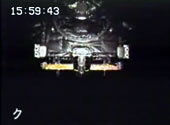 The H-IIA Launch Vehicle No. 11 (H-IIA F11) with the Engineering Test Satellite VIII "KIKU No. 8" (ETS-VIII) onboard was launched at 3:32 p.m. on December 18, 2006 (Japan Standard Time, JST.) The launch vehicle flew smoothly, and, at about 28 minutes after liftoff, the "KIKU No. 8" separation was confirmed.
We would like to express our profound appreciation for the cooperation and support of all related personnel and organizations that helped contribute to the successful launch of the H-IIA F11.
[Updated on Dec. 18, 2006]
|
We are now ready for launch!
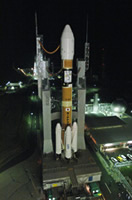 The launch countdown has started for the KIKU No. 8/ H-IIA F11 in Tanegashima. The scheduled launch time is 3:32 p.m. The preparation status is being updated under the "Countdown Report" in the special site for the launch. The live launch report will start at 2:30 p.m. You can enjoy the report through the Internet, at some JAXA broadcast sites, on big screens on the streets, in science museums, and via cable TV.
[Updated on Dec. 18, 2006]
|
Launch postponement of the KIKU No. 8/H-IIA F11
The launch of the KIKU No. 8/H-IIA F11 scheduled on Dec. 16 has been postponed due to clouds including a freezing layer observed above the launch site. There is little possibility for the weather to recover by the time of the launch.
The new launch date has been set for December 18 (Mon), 2006 (Japan Standard Time, JST). The scheduled launch time is between 3:32 thru 3:44 p.m. (JST.)
[Updated on Dec. 16s, 2006]
|
Tanegashima Report 4
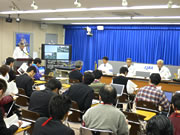 Hello from Tanegashima Reporter W.A.
It is cloudy here today with a temperature of 16.4 degrees. This kind of mild weather in December is not common even in Tanegashima.
There is one more day to launch. The Y-0 (=L-0, one day prior to launch) press briefing was held at 1:30 p.m., and all seats in the conference room were occupied by media-related personnel.
Launch preparations are progressing smoothly. There is, however, a small concern over the weather forecast. We are closely watching the weather conditions as there is a possibility of lightening around the time of the launch. We continue carrying out preparation operations for tomorrow as scheduled.
We will do our best for a successful launch, so please support us.
[Updated on Dec. 15, 2006]
|
Tanegashima Report 3
 Hello from Tanegashima Reporter W.A.
The launch is two days away, and the media is getting busier. The weather at the Tanegashima Space Center was rainy at 3:00 p.m. on Dec. 14, and the temperature was 16.6 degrees Celsius. It is humid, but not cold.
JAXA held a Y-1 (=L-1, or a two day prior to launch) press briefing from 1:30 p.m. today. Not many reporters attended today probably because we still have two more days to launch.
Launch preparations for all systems including the launch vehicle and satellite are progressing smoothly. The weather around the time of the launch was forecasted and determined to be acceptable in terms of rain and wind. Launch operations will continue as scheduled.
Please look forward to a successful launch on the 16th.
[Updated on Dec. 14, 2006]
|
Tanegashima Report 2
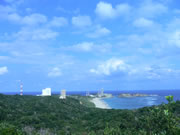 Today's report is from Reporter M.T. at the Tanegashima Space Center.
The weather here is fine with a temperature of 23.9 degrees. It is like Spring and the ocean is sparkling beautifully in the sunshine.
Today, I would like to explain the configuration of the H-IIA F11.
The launch vehicle that launches the KIKU No. 8 is a new type called the H2A204. The KIKU No. 8, which weighs 5.8 tons, is one of the largest class satellites that JAXA has launched. The H2A204 is a launch vehicle newly developed by JAXA in order to launch this heavy satellite. The H2A204 is equipped with four solid rocket boosters (SRB-As), two more than the conventional two SRB-As, to improve launch capability. For the two additional SRB-As, some parts of the core launch vehicle were also enhanced.
On December 16, one of the largest launch vehicles in JAXA's history will debut as a member of the H2A series. Please pay attention to the speed and dynamism at liftoff (and also the huge sound for those who are on site.)
Enjoy the launch on site or through the live broadcast.
[Updated on Dec. 13, 2006]
|
Tanegashima Report 1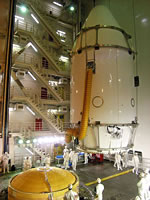
The launch is not far away, and we would like to update the Topics section more often from today. Please check our site from time to time.
Today, as a first Tanegashima Report, we hear from S.K. in Tanegashima.
Hello from Reporter S.K. in Tanegashima.
It is fair weather at the Tanegashima Space Center at 9:00 a.m. on Dec. 11. The temperature is 14 degrees Celsius, a very pleasant morning. An earthquake hit the Amami Region at 0:28 this morning which shook Tanegashima, too. However, for the KIKU No. 8, such a minor earthquake must have been just a warm-up compared with the vibrations it will experience at launch.
Launch preparations for the KIKU No. 8 are progressing smoothly. Operations for the satellite, which is now onboard the launch vehicle, are controlled remotely from the Spacecraft and Fairing Assembly Building No. 2 (SFA2.) The condition and preparation status of the KIKU No. 8 can also be monitored 24/7 from the Tracking and Control Room at the Tsukuba Space Center. Therefore the latter can be a backup in case equipment in the SFA2 has trouble.
On Dec. 10, the final rehearsal to confirm the process on the launch day was completed, thus we are in good spirits, fully ready for the launch in Tanegashima.
To conclude today's report, I interviewed Mr. Noda of the KIKU No. 8 Project, who will supervise the preparation operations of the satellite on the launch day.
He said, "As we completed the rehearsal, we confirmed all procedures. We don't expect any problems with the launch. My only concern is my habit of talking to myself. I will try not to deliver any unnecessary monologue or give strange instructions to the equipment which sends commands to the satellite on the launch day."
[Updated on Dec. 12, 2006]
|
Encapsulated KIKU No. 8 moved to the VAB Countdown to launch
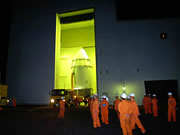 The "KIKU No. 8 (ETS-VIII)," which had been encapsulated by fairing at the Spacecraft and Fairing Assembly Building (SFA), left the SFA for the Vehicle Assembly Building (VAB) on the night of Dec. 7. The transportation went smoothly. In the VAB, the encapsulated KIKU No. 8 will be loaded onto the launch vehicle to be ready for the coming launch.
[Updated on Dec. 8, 2006]
|
Mating operation with the PAF completed
 The KIKU No. 8 (ETS-VIII) is now in the final launch preparation phase after completing the installation of pyrotechnics and propellant loading at the Spacecraft and Fairing Assembly Building No. 1 (SFA.) In cooperation with the launch vehicle team, the mating operations of the satellite with the Payload Attachment Fitting (PAF) were carried out at the SFA. The PAF is a device to connect the satellite and launch vehicle.
After encapsulation of the satellite by a fairing at the SFA, the satellite will be transported to the Vehicle Assembly Building (VAB) to be loaded onto the launch vehicle. Further cooperation between the satellite and launch vehicle teams will be necessary.
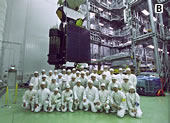 Photo A:PAF mating operation
The corn shaped device under the satellite is the PAF
Phot B:The PAF mating operations were successfully completed by cooperation of the two teams. You can see the scaffold for fairing encapsulation operations on the right side behind the satellite.
[Updated on Dec. 1, 2006]
|
Tracking and control rehearsal for KIKU No. 8
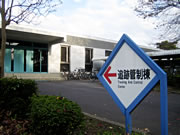 The tracking and control team of the KIKU No. 8 held a launch rehearsal between Nov. 13 and 17. This is the third and last rehearsal for all tracking and control operations from the launch to solar array paddle deployment and large antenna deployment. The operation was very similar to a real operation. The team will make every effort to ensure that the operation is fully ready for the launch.
[Updated on Nov. 20, 2006]
|
Preparations for launch of KIKU No. 8 (ETS-VIII) and H-IIA F11 running smoothly
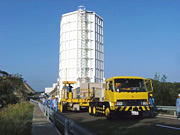 On the morning of Nov. 2 at the Tanegashima Space Center (TNSC), the "KIKU No. 8 (ETS-VIII)" completed its post-transportation function verification, and was moved from the Spacecraft and Fairing Assembly Building No. 2 (SFA2) to the Spacecraft and Fairing Assembly Building (SFA) for final preparations.
On the ninth, the cryogenic test for the H-IIA Launch Vehicle Flight No.11 (H-IIA F11) was held at the TNSC.
Preparations for the payload and launch vehicle are running smoothly ahead of the launch scheduled for next month.
[Updated on Nov. 14, 2006]
|
Cryogenic test
 On Nov. 9, the cryogenic test for the H-IIA Launch Vehicle Flight No. 11 was held at the Tanegashima Space Center. After the acquired data was reviewed, JAXA confirmed that the test objective had been achieved.
The cryogenic test is to verify if all functions of the launch vehicle, as well as the launch facilities, work properly by loading liquid propellants following exactly the same procedures as on the launch day.
The cause of some incompatibilities found during the cryogenic test will be investigated, and proper measures will be taken to correct them.
[Updated on Nov. 13, 2006]
|
KIKU No.8 (ETS-VIII?open to the press
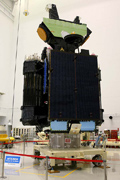 The Engineering Test Satellite "KIKU No. 8 (ETS-VIII)", which arrived at the Tanegashima Space Center in September, was open to the press on Nov. 1, and the satellite showed its body wrapped in black insulation material with its stowed antennas and solar array paddles. The stowed KIKU is 7.3 meters in height, 3.7 meters in length, and 4.6 meters in width. It will be 5.8 tons (at the time of liftoff), which is the heaviest satellite in Japanese satellite history. Its launch vehicle, H-IIA F 11, is equipped with four solid rocket boosters (SRB-As), two more SRB-As than the conventional H-IIA with two SRB-As, to increase launch capability.
[Updated on Nov. 6, 2006]
|
Final preparation is underway for launch
 Various activities are underway ahead of the launch of the "KIKU No. 8" including announcements about the launch day, its nickname, and its symbol character "KIKU Hachi-zo." The "KIKU No. 8 (ETS-VIII)," which had been delivered to the TNSC, was unpacked and reassembled, and a final functional verification test was carried out.
As the final preparation for launch, the "KIKU No. 8" will be loaded with propellant, installed with pyrotechnics, and placed on the launch vehicle.
The satellite will be open to the press on November 1 at the Tanegashima Space Center.
Photo A : KIKU No. 8 almost reassembled
Photo B : Testing the propulsion system
Photo C : The Spacecraft and Fairing Assembly Building 2 at the TNSC, where preparation and tests are underway
[Updated on Oct. 30, 2006]
|
Launch day is set! Special site is open!
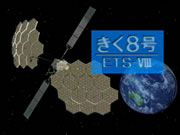 The launch day of the Engineering Test Satellite VIII "KIKU No. 8 (ETS-VIII)" is set for December 16, 2006. We have opened a special site to provide you with the latest information about "KIKU No. 8 (ETS-VIII)"and H-IIA Launch Vehicle No. 11 (H-IIA No.11.) Please enjoy this site.
[Updated on Oct. 25, 2006]
|
Engineering Test Satellite VIII (ETS-VIII) nicknamed "KIKU No. 8"
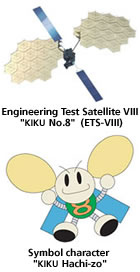 The Engineering Test Satellite VIII (ETS-VIII) was nicknamed "KIKU No.8" ("KIKU" means "chrysanthemum" in English.) The ETS series has been named "KIKU" since its first satellite.
The catchphrase for the "KIKU No. 8" is:
Opening the door to the future by deploying big antennas and providing security
-- Large-size satellite opens up new mobile phone communication world --
JAXA has been conducting the ETS series project with the aim of achieving satellite technology that can meet the needs of the future.
"KIKU No. 8," or the 8th ETS, will challenge technological standards in communications and positioning that can make our life more convenient and comfortable.
The ETS-VIII symbol character "KIKU Hachi-zo" was born to help the public feel closer to the satellite. We hope you like both the satellite and the mascot.
[Updated on Oct. 23, 2006]
|
LDREX-2 antenna deployment confirmed
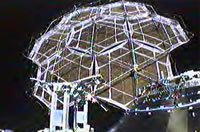 Concerning the deployment experiment of the Large Deployable Reflector Small-sized Partial Model 2 (LDREX-2) launched by the Ariane 5 launch vehicle at 5:56 a.m. on Oct. 14, 2006 (Japan Standard Time) JAXA confirmed the antenna deployment by images acquired at the Malindi Station in the Republic of Kenya. It is expected to take a week to 10 days to find the final result of the deployment experiment as we have to analyze telemetry data acquired during the experiment.
(Image taken from the back of the antenna)
[Updated on Oct. 16, 2006]
|
H-IIA arrives at TNSC
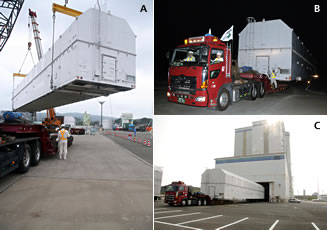 The H-IIA Launch Vehicle No. 11 has arrived at the Tanegashima Space Center (TNSC). Between Oct. 1 and 2, the transportation container of the launch vehicle was unloaded from the ship at the port in Tanegashima (Photo A), transported to the TNSC (Photo B), and arrived at the Vehicle Assembly Building. Launch preparation operations have started.
[Updated on Oct. 3, 2006]
|
ETS-VIII arrived at the TNSC
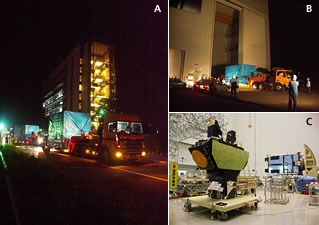 The Engineering Test Satellite VIII (ETS-VIII), which completed the System Proto-flight Test (System PFT) at the Tsukuba Space Center (TKSC), was delivered to Tanegashima from Tsukuba.
On the evening of Aug. 31, the satellite left the TKSC (Photo A,) was transported via land and sea, and arrived at the Spacecraft and Fairing Assembly Building #2 at the Tanegashima Space Center (TNSC) on Sep. 4 (Photo B.) After the arrival, the satellite was unpacked (Photo C.) Since the ETS-VIII is a big satellite, large parts were detached from the main body for packing, and land transportation was carried out during the night.
The launch preparation is smoothly underway at the Tanegashima Space Center.
[Updated on Sep. 1, 2006]
|
|
|
|